Construction & Administration
Unlike the war cemeteries for Allied casualties, which generally lie with an open aspect, highly visible in the landscape about them, with imposing edifice memorials to mark their sites, the German cemetery near Neuville-St. Vaast is discreetly designed and more understated. Located amidst the farming fields of the rolling Artois landscape, it is screened from the outside by an earth embankment planted with tall hedges, which mostly obscures it from its surroundings. There is no central building, but a small chapel at the gateway which holds directories that list alphabetically the names of the soldiers' bodies that are interred within the cemetery, identifying the plot and section for each grave and providing a map showing their location.
Between 1975 and 1983 the VDK completely reorganized the cemetery, replacing deteriorating wooden crosses that previously marked the graves with new ones made of metal with engraved specifics: Name, Rank and Date of Death. Each cross lists four individual names, since it is the location marker for four graves in the plot it stands over. [4]
Within the cemetery there are 129 stone grave markers, of a different design from the uniform metal grey cross, displaying the Star of David for the graves of Jewish-German soldiers who fell in action fighting for Imperial Germany. [5]
A World War I battlefield stone war memorial, fashioned originally by the men of Hanoverian Infantry Regiment Nr.164, was relocated into the cemetery's grounds post-war. [6]
Several small dug-out fortifications still exist within the cemetery's perimeter, relics from the fighting that raged across the area in World War I.

Arras is the prefecture of the Pas-de-Calais department, which forms part of the region of Hauts-de-France; before the reorganization of 2014 it was in Nord-Pas-de-Calais. The historic centre of the Artois region, with a Baroque town square, Arras is in northern France at the confluence of the rivers Scarpe and Crinchon.
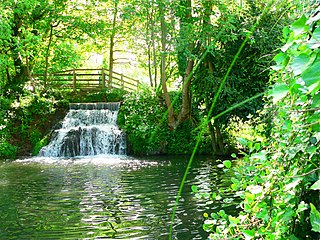
Souchez is a commune in the Pas-de-Calais department in the Hauts-de-France region of France. It is located 3.2 kilometres (2.0 mi) northwest of the Canadian National Vimy Memorial dedicated to the Battle of Vimy Ridge and the missing First World War Canadian soldiers with no known grave; the Memorial is also the site of two Canadian cemeteries.

La Cambe is a Second World War German military war grave cemetery, located close to the American landing beach of Omaha, and 25.5 km (15.8 mi) north west of Bayeux in Normandy, France. It is the largest German war cemetery in Normandy and contains the remains of over 21,200 German military personnel. Initially, American and German dead were buried in adjacent fields but American dead were later disinterred and either returned to the US or re-interred at the Normandy American Cemetery and Memorial, 15 km (9.3 mi) away. After the war over 12,000 German dead were moved from approximately 1,400 field burials across Normandy to La Cambe. The cemetery is maintained and managed by the voluntary German War Graves Commission.

The Canadian National Vimy Memorial is a war memorial site in France dedicated to the memory of Canadian Expeditionary Force members killed during the First World War. It also serves as the place of commemoration for Canadian soldiers of the First World War killed or presumed dead in France who have no known grave. The monument is the centrepiece of a 100-hectare (250-acre) preserved battlefield park that encompasses a portion of the ground over which the Canadian Corps made their assault during the initial Battle of Vimy Ridge offensive of the Battle of Arras.
Saint Vaast or Saint-Vaast may refer to:

Neuville-Saint-Vaast is a commune in the Pas-de-Calais department in the Hauts-de-France region of France. It is located 3.2 kilometres (2.0 mi) south of the Canadian National Vimy Memorial dedicated to the Battle of Vimy Ridge. The Memorial was built on Hill 145, the highest point of the ridge to commemorate the battle and the Canadian soldiers who lost their lives during the First World War. The Memorial is also the site of the Canadian Cemetery No. 2, Neuville-St.-Vaast and Givenchy Road Canadian Cemetery, Neuville-St.-Vaast.

Orglandes War Cemetery is a German World War II cemetery in Normandy, France. It is located on the northern edge of the village of Orglandes, about 30 km (19 mi) south east of Cherbourg and 7 km (4.3 mi) west of Sainte-Mère-Église on the Cotentin Peninsula. The burials come from summer 1944, immediately following D-Day and the Battle of Normandy. It is the second smallest of the six German war cemeteries in Normandy with a little over 10,000 burials. The cemetery is maintained and managed by the voluntary German War Graves Commission.
The German War Graves Commission is responsible for the maintenance and upkeep of German war graves in Europe and North Africa. Its objectives are acquisition, maintenance and care of German war graves; tending to next of kin; youth and educational work; and preservation of the memory to the sacrifices of war and despotism. Former head of the Bundeswehr Wolfgang Schneiderhan was elected President of the organisation in 2016, succeeding SPD politician Markus Meckel. The President of Germany, currently Frank-Walter Steinmeier (SPD), is the organisation's patron.

The Cannock Chase German Military Cemetery is on Cannock Chase, Staffordshire, England. The cemetery contains nearly 5,000 burials from both the First and Second World War. The burials are mainly German and Austrian nationals with a very small number of Ukrainians.
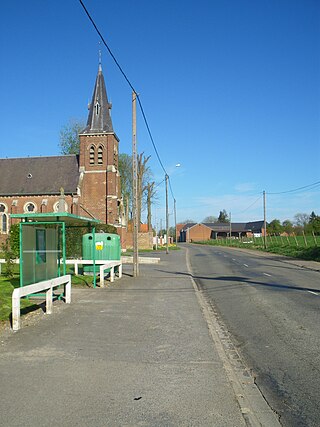
Gommecourt is a commune in the Pas-de-Calais department in the Hauts-de-France region of France.
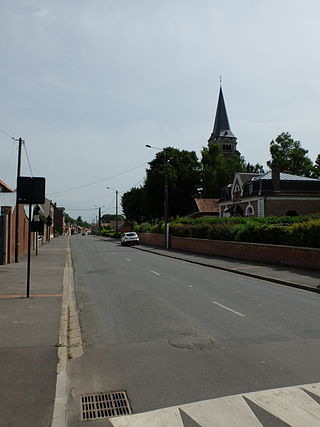
Neuville-Vitasse is a commune in the Pas-de-Calais department in the Hauts-de-France region of France.

Canadian Cemetery No. 2 is a Commonwealth War Graves Commission burial ground for the dead of World War I situated on the grounds of the Canadian National Vimy Memorial Park near the French town of Neuville-Saint-Vaast.
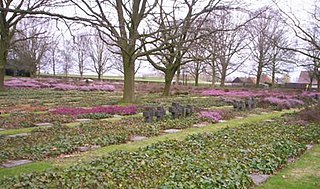
The Hooglede German war cemetery is a military cemetery in the Belgian town of Hooglede, six kilometer northwest of Roeselare. It is located at the east side of Hooglede. It contains 8,241 buried German soldiers from World War I.

Champigny-Saint-André is a German World War II cemetery in Normandy, France. It is located 5 kilometers South of the village of Saint-André-de-l'Eure, about 25 km (16 mi) south east of Évreux. The burials come from the summer of 1944, as the Allies pushed out of Normandy towards Paris. It is the second largest of the six German war cemeteries in Normandy with a nearly 20,000 burials. The cemetery is maintained and managed by the voluntary German War Graves Commission.

Marigny German war cemetery is a German World War II cemetery in Normandy, France. It is located 12 km (7.5 mi) west of Saint-Lô. The cemetery contains in excess of 11,000 German military personnel and is maintained and managed by the German War Graves Commission.

Mont-de-Huisnes German war cemetery is a military war grave mausoleum, located 1 km north of Huisnes-sur-Mer and a few kilometres southwest of Avranches, France. It presently contains in nearly 12,000 burials of German military personnel of World War II, plus some women and children. It is maintained and managed by the German War Graves Commission.
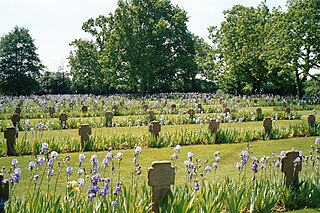
Saint-Désir-de-Lisieux is a Second World War German military war grave cemetery, located close to the village of Saint-Désir and 4 km (2.5 mi) west of Lisieux in the Calvados department, Normandy, France. It is located adjacent to the British Saint-Désir War Cemetery and is unique as the two burial grounds are linked by a pathway. It is the smallest German war cemetery in Normandy and contains the remains of 3,735 German military personnel. The cemetery was created by the British Graves Registration Commission in August 1944 with British and German casualties buried in adjacent fields.
Maison Blanche was a department store in New Orleans, Louisiana.
Funerary and memory sites of the First World War (Western Front) is a UNESCO World Heritage Site which incorporates 139 cemeteries and memorials on the Western Front of the First World War. On 20 September 2023, UNESCO designated the locations as a World Heritage site.















